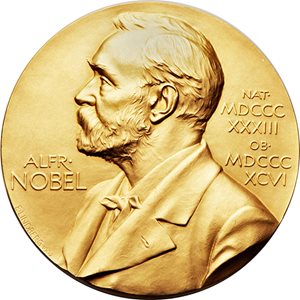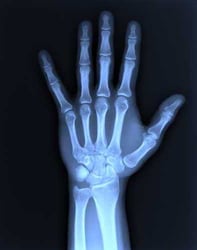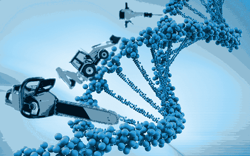 Every fall, the world comes to attention for the unveiling of the Nobel Prizes, considered the most prestigious awards for achievements in science and the humanities. Per Alfred Nobel’s will, the original five prizes were to be awarded “for the greatest benefit to humankind,” and in 1969, the Economics prize was added to the mix.
Every fall, the world comes to attention for the unveiling of the Nobel Prizes, considered the most prestigious awards for achievements in science and the humanities. Per Alfred Nobel’s will, the original five prizes were to be awarded “for the greatest benefit to humankind,” and in 1969, the Economics prize was added to the mix.
Over the past century-plus, hundreds of individuals have been recognized for their landmark discoveries that shaped our understanding of the natural world and improved the human condition. I decided to highlight some of the historic honors in the fields of medicine, physics, and chemistry, although the achievements in literature, peace, and economics are also laudable (this is a science blog, after all). While it is perhaps arbitrary to limit this to just four awards per field (plus some follow-up awards stemming from the initial discovery), these are discoveries that not only accelerated their fields, but also gave the greatest benefit to humanity through the advancement of life and medical science as Nobel had hoped.
Medical Marvels
Originally known as the Nobel Prize in Medicine, Nobel’s will actually designated this award to be eligible to anyone studying medicine or physiology, which should encompass most, if not all, biologists and medical doctors studying a life science. The chronology of the awards shows how the work of each Nobel Laureate contributed to discoveries branching off their legacies, and modern science is all the better because they pioneered breakthrough research, again, for the greatest benefit to humankind.
- Fighting Diabetes
For over 50 years before this discovery, medical science knew of the islets of Langerhans within the pancreas, and that something within its secretions played a role in human digestion and diabetes. Because diabetes was nearly impossible to treat and patients with the disease didn’t live for very long, the best management was to employ a strict diet that would slow the disease but still lead to death by starvation. Thanks to previous findings stemming from the discovery of the islets of Langerhans, a collaboration between Frederick Banting and John Macleod was successful in the isolation and testing of insulin, which they first showed could reduce the blood sugar of a diabetic dog, and then soon after, was able to improve the condition of a diabetic boy without any major side effects. This therapeutic innovation was rewarded with the 1923 Nobel Prize and paved the way to an open patent that would ensure insulin be made available to all who needed it at an affordable cost--at least you would hope it stays that way!
- The War Against Bacteria
 In a bit of serendipity, the relative lack of sterile technique by Sir Alexander Fleming precipitated a landmark discovery. The story told in many a biology textbook suggests that Fleming plated some Staphylococcus cultures and then left on holiday. When he returned, Fleming observed that some Penicillium mold had grown on his plates, and surrounding those molds, no bacteria appeared to grow. Over the years, Fleming and his colleagues were able to isolate the substance, now called penicillin, and eventually it was used to treat a variety of bacterial illnesses. Penicillin gained attention when it was used to treat soldiers during World War II. For this life-saving discovery, Fleming and two others were awarded the 1945 Nobel Prize, and a new arms race between antibiotics and bacterial antibiotic resistance began that rages on today. Another Nobel Prize in 1952 was awarded to Selman Waksman for discovering streptomycin for the treatment of tuberculosis.
In a bit of serendipity, the relative lack of sterile technique by Sir Alexander Fleming precipitated a landmark discovery. The story told in many a biology textbook suggests that Fleming plated some Staphylococcus cultures and then left on holiday. When he returned, Fleming observed that some Penicillium mold had grown on his plates, and surrounding those molds, no bacteria appeared to grow. Over the years, Fleming and his colleagues were able to isolate the substance, now called penicillin, and eventually it was used to treat a variety of bacterial illnesses. Penicillin gained attention when it was used to treat soldiers during World War II. For this life-saving discovery, Fleming and two others were awarded the 1945 Nobel Prize, and a new arms race between antibiotics and bacterial antibiotic resistance began that rages on today. Another Nobel Prize in 1952 was awarded to Selman Waksman for discovering streptomycin for the treatment of tuberculosis.
- The Incredible Versatile Antibody
At ABclonal, we are famous for our expertise in antibody characterization and production, but it was thanks to these discoveries that we and others have the knowledge we enjoy today. As cell biology and purification technologies advanced during the 1970s, scientists discovered how to produce monoclonal antibodies of desired specificity using hybridomas, for which Niels Jerne, Georges Kohler, and Cesar Milstein were awarded the 1984 Nobel Prize. To help later in developing recombinant antibodies, Susumu Tonegawa was able to delineate the exact mechanism by which B cells (and later by others, T cells) could rearrange their V(D)J segments of DNA to form the billions of potential specificities conferred to antibodies. Tonegawa was awarded the 1987 prize to recognize his brilliant experiments.
- A New Revolution in Personalized Therapy
Modern therapies are designed to target specific molecules and pathways rather than being broad spectrum inhibitors or chemotherapies. As medical knowledge expands, scientists have learned to pinpoint the exact targets preferentially expressed in specific disease states, including cancer. Thanks to the discoveries by James Allison (one of my former professors!) and Tasuku Honjo, medical science is now working on more productively leveraging the host immune system to attack cancer with fewer negative side effects for the patient. These discoveries were recognized with the 2018 Nobel Prize.
You Can’t Spell “Physiology” Without “Physics”
When I was teaching high school science, I dabbled in every aspect, including chemistry and physics, to give my students a greater understanding of how scientific principles contributed to every field. I described physics as the science of how particles collided with each other, chemistry as physics that caused reactions, and biology as the chemistry of life. So, the Nobel-worthy discoveries in physics are just as important as in the other fields!
- I Can See Right Through You
 In the late 19th Century, Wilhelm Rontgen discovered the X-ray, which he quickly used to take radiographs of his wife’s hand as well as his friend’s hand. Rontgen is considered the father of radiology, and X-ray technology continues to be used in hospitals and sports arenas even today as a primary diagnostic tool. For his contributions to physics, and by extension, medicine, Rontgen was awarded the inaugural Nobel Prize in Physics in 1901. As a pioneering scientist, Rontgen also has the roentgen named after him as a measurement unit of X-ray and gamma radiation, along with his own element on the periodic table. Various other Nobel Prizes were awarded for work on X-rays, which also paved the way to X-ray crystallography, one of the primary tools in elucidating protein structure.
In the late 19th Century, Wilhelm Rontgen discovered the X-ray, which he quickly used to take radiographs of his wife’s hand as well as his friend’s hand. Rontgen is considered the father of radiology, and X-ray technology continues to be used in hospitals and sports arenas even today as a primary diagnostic tool. For his contributions to physics, and by extension, medicine, Rontgen was awarded the inaugural Nobel Prize in Physics in 1901. As a pioneering scientist, Rontgen also has the roentgen named after him as a measurement unit of X-ray and gamma radiation, along with his own element on the periodic table. Various other Nobel Prizes were awarded for work on X-rays, which also paved the way to X-ray crystallography, one of the primary tools in elucidating protein structure.
- What Was Unseen Now Becomes Clear
Optics are a fundamental field in physics, and governs how we capture, focus, and perceive light, either through our own eyes or with assistance from lens-based devices. If you have ever taken a biology class or worked in a lab that does cell culture, you will have used a phase-contrast microscope, which allows you to visualize the cells in suspension or as they adhere to cell culture-treated plates. For inventing this indispensable research tool, Dutch scientist Frits Zernike received the 1953 prize that transcended mere physics.
- Small Wonders
By the time I started learning biology, electron microscopy (EM) was a routine technology to visualize ultra-small objects that could not be resolved using a traditional light microscope. I had the opportunity to use transmission EMs and the images I saw were stunning and beautiful. I also got the chance to work with cryogenic EM, a technology that was eventually rewarded by the 2017 Nobel Prize in Chemistry. However, the initial recognition for EM was the 1986 Nobel Prize in Physics, awarded jointly to Ernst Ruska for inventing the first reported EM, and Gerd Binnig and Heinrich Rohrer for designing the scanning EM, also known as scanning tunneling microscopy.
- A New Era of Biological Imaging
The charge-coupled device (CCD) was invented about 50 years ago and is now used in many digital imaging applications, including astronomy and biology. Coupled with the explosion of personal computers in everyday life and laboratory research, CCD cameras were used to expand the methods used to reconstruct images, and to glean new data from a microscope image that was not previously possible. For this invention, Willard Boyle and George Smith shared the 2009 prize with Charles Kao, who separately developed fiber-optic communication.
Emphasizing the “Chemistry” in “Biochemistry”
I always thought it was unfair that the Nobel Prize in Chemistry was often awarded to biochemists, but perhaps that was unfair in itself, because much of biology requires a refined approach in physical and organic chemistry to drive experimentation. The laws of chemistry must also be followed by living organisms, and chemistry is often referred to as the “central science” because it connects both the physical and the living world. Many of the chemistry Nobel laureates discovered fundamental principles of chemistry that we take for granted today, which is amazing given how much of what they accomplished now fits in an introductory chemistry textbook.
- The Chemistry Behind Photosynthesis
 Melvin Calvin was one of the most famous educators at my alma mater, where he still has a building named after him. Those who didn’t go to Berkeley remember Calvin as the researcher who dissected the eponymous Calvin cycle, the biochemical pathway by which plants and other photosynthetic organisms convert carbon dioxide into biological compounds such as glycerol and glucose, from which the more complex building blocks of life are derived. The clarification of this fundamental life process earned Calvin the 1961 Nobel Prize in Chemistry.
Melvin Calvin was one of the most famous educators at my alma mater, where he still has a building named after him. Those who didn’t go to Berkeley remember Calvin as the researcher who dissected the eponymous Calvin cycle, the biochemical pathway by which plants and other photosynthetic organisms convert carbon dioxide into biological compounds such as glycerol and glucose, from which the more complex building blocks of life are derived. The clarification of this fundamental life process earned Calvin the 1961 Nobel Prize in Chemistry.
- Structure Begets Function
The central dogma had been understood for some time, as DNA contains the genetic code that generates messenger RNA, which in turn is translated into a polypeptide. What wasn’t as clear was how the polypeptide contributed to phenotype. Working with ribonuclease, Christian Anfinsen, Stanford Moore, and William Stein determined that it was the amino acid sequence of the protein that conferred the native structure of the protein, while also determining its catalytic activity and other functions. The trio were awarded the 1972 prize.
- A World-Changing Technology
If you have ever worked in a lab, chances are you are intimately familiar with the polymerase chain reaction (PCR), sometimes to the point of frustration (we can help with that). Kary Mullis is often credited with the primary PCR methodology we still employ today, while Michael Smith contributed to site-directed mutagenesis techniques using similar methods. Both were awarded the 1993 prize for this essential laboratory tool.
- So You Want to Edit a Genome
 As you may have seen, the Nobel Prizes discussed so far have been a veritable boys’ club (and hopefully science institutions work to change that). This final entry in our list honors two brilliant women, Jennifer Doudna and Emmanuelle Charpentier, for their discovery and invention of CRISPR-Cas9 gene editing technology. This breakthrough discovery has the very real potential of changing the way medical science builds therapeutic strategies against genetic diseases.
As you may have seen, the Nobel Prizes discussed so far have been a veritable boys’ club (and hopefully science institutions work to change that). This final entry in our list honors two brilliant women, Jennifer Doudna and Emmanuelle Charpentier, for their discovery and invention of CRISPR-Cas9 gene editing technology. This breakthrough discovery has the very real potential of changing the way medical science builds therapeutic strategies against genetic diseases.




